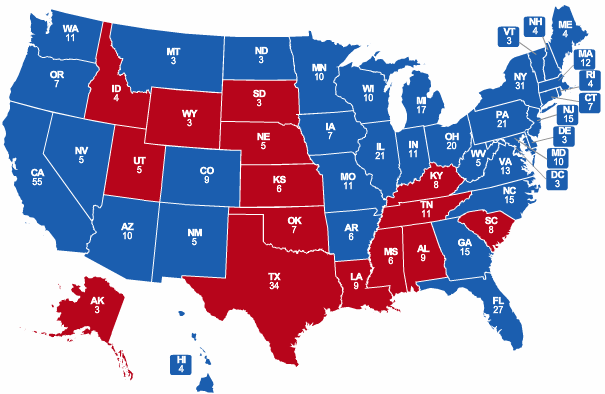Democratic ‘Safe’ Seats Not So Safe
Republicans are suddenly targeting -- and Democrats in some cases are conceding -- House seats that were until recently considered out of play.
Republicans are suddenly targeting — and Democrats in some cases are conceding — House seats that were until recently considered out of play, Jeff Zeleny reports for NYT.
As Republicans made new investments in at least 10 races across the country, including two Democratic seats here realin eastern Ohio, Democratic leaders took steps to pull out of some races entirely or significantly cut their financial commitment in several districts that the party won in the last two election cycles.
Representatives Steve Driehaus of Ohio, Suzanne M. Kosmas of Florida and Kathy Dahlkemper of Pennsylvania were among the Democrats who learned that they would no longer receive the same infusion of television advertising that party leaders had promised. Party strategists conceded that these races and several others were slipping out of reach.
With three weeks remaining to save its majority, the Democratic Congressional Campaign Committee has increased its spending on two New York races, along with at-risk seats in Colorado, Georgia, Illinois, Kentucky and Massachusetts, setting up a map of competitive districts that is starkly different from when the campaign began.
The strategic decisions unfolded at a feverish pace on Monday over an unusually wide playing field of nearly 75 Congressional districts, including here in Ohio, a main battleground in the fight for the House and the Senate.
This is attributable to an anti-incumbent tide that’s benefiting Republicans and, in turn, generating a massive fundraising advantage.
Republican confidence seems well advised. Three weeks out, RealClearPolitics projects 212 Republican seats, 185 Democratic seats, and a whopping 39 tossups. If the GOP gets 1/3 of the tossups, they’ll retake the majority.
Nate Silver, who uses a formula to assign the tossups, figures the Republicans will wind up with 226.5 seats and the Democrats 208.5. (Obviously, there are no half seats.)
Recall that the Democrats currently hold 255 seats, to 178 for the GOP.








And just to round out the picture a bit, Congressional Quarterly, which has been tracking all the House races for a long time now, currently has the Dems at 211, the GOP at 190, and 34 tossups.
RealClear is a rather unabashedly GOP site, so their numbers must be seen as the result of a GOP-favorable spin.
@Tano: LOL!
Tano clearly doesn’t actually read RealClearPolitics, nor does Tano bother to understand RCP’s methodology.
RCP simply takes all of the polls, averages the latest result from each, and reports the outcome. PPP is weighted exactly the same as Rasmussen, for instance, because each is just one of the many polls sampled.
To claim any particular bias in RCP’s average poll results is simply a sign of ignorance.
A projection of 226 (.5?!?) seats for the Republicans is a fairly safe (and, at this point, conservative) projection, corresponding to a pickup of 48 (.5) seats.
I’m actually thinking the final number is closer to 60 net seats picked up by the Republicans.
Tano also misses that Nate Silver, a democrat, also predicts an outcome similar to RCP. His willful ignorance is about to be hit hard in 3 weeks if these estimates end up true.
Tano didn’t “miss” the fact that Nate made a prediction, because Tano read the entire post, and reads Nate’s work on a daily basis.. And Tano began his comment indicating that, given the data that James gave us, I was simply adding the one other major source that has been tracking these races for a long time.
I don’t quite see how you judge Nate’s model’s projection as being the same as RCP’s projection. Nate’s model has no tossups- it projects all the races. RCP allows for tossups, so how do you make a comparison?
If all of RCP’s tossups go to the Dems, then the GOP just has 211. If the GOP gets all the tossups, then they end up with 250. So that is RCP’s projected range for the GOP, 211-250.
Nate’s model currently has the GOP with 226.5. That is within RCP’s range, but it is a pretty broad range.
FWIW, Rothenberg has a GOP projected pickup of 29 seats, plus he has 15 tossups, 13 of which are Dems. Which seems to my math to have a range of 27-42 GOP pickups, or 205-220 seats..
Charlie Cook has Dems at 198, GOP at 197 and 40 tossups. So that would give the GOP a range of 197-237. Which translates to a 19-59 seat pickup.
If we take Nate’s point prediction and the midpoint of the ranges for these others that have tossups, then the projections for GOP seats are, in ascending order: 207, 212.5, 217, 224.5, 230.5.
And, if we take the average of all those estimates, it comes to 218.3 seats.
Wow, what a gross mis-representation of Cook.
Cook basically NEVER puts an incumbent at anything less than “tossup”. (That he actually moved 2-3 incumbent Ds into “leans Republican” was an absolute shocker yesterday.)
What Cook actually shows is that the Democrats have 115 seats in play, while the Republicans only have 17 seats in play – and it is the relative numbers of seats in play that matters when analyzing Cook.
The Republicans have 162 of 179 seats that are safe.
The Democrats have 141 out of 256 seats that are safe.
You do the math.
“Tano clearly doesn’t actually read RealClearPolitics, nor does Tano bother to understand RCP’s methodology.”
Well hello to you too, Chip Bennet. Nothing quite like making a good first impression, eh?
“RCP simply takes all of the polls, averages the latest result from each, and reports the outcome.”
Actually, since we are talking about House races, it is often the case that there simply is no polling by major firms. If you were to , like, actually , y’know, _read_ RCP, and look at the numbers for the particular races, you might realize that some of them, for example, have one internal (Republican) poll – that is what defines how RCP classifies the race. Others have no data at all.
And if you were to regularly, y’know, _read_ RCP other polling data, you would realize that their choice of polls is not comprehensive, and their timing of when to add the poll, and when to drop it, is often done in a way to make the GOP numbers look better.
And if you were to ever, y’know, actually _read_ their articles in which they analyze data, and pontificate about what it all means, you would see that they relentlessly pick out all the GOP favorable points and exclude the others.
I don’t think they make any efforts to hide their partisan leanings. In fact I don’t fault them for it. They have a point of view, they don’t really make an effort to hide it, and so I use their site, which is quite valuable in many ways, but I do so with my eyes open. Thats how it probably should be.
Now maybe if address me again, you could try to communicate like a grown-up and leave out the insults and general rudeness?
“Wow, what a gross mis-representation of Cook.”
Hmmm.
Here is the site – everyone can judge for themselves.
http://www.cookpolitical.com/
“The Republicans have 162 of 179 seats that are safe.
The Democrats have 141 out of 256 seats that are safe.
You do the math.”
No Chip, you do the math. What does this mean to you?
Yes, you report the safe seats accurately. Now what do you do with the likely seats? How do you calculate how many Likely Dem seats will be lost, or how many Likely GOP seats will be lost? And the leaners? What is your magic formula that tells you that some, most, or all of the Lean Dems will actually go the other way?
You are predicting 60 seat pickup? How do you arrive at that number? Are you going to claim that Charlie Cook, or anyone else, agrees with you?
Why not actually say something, instead of giving us the ol’ rant-boy routine?